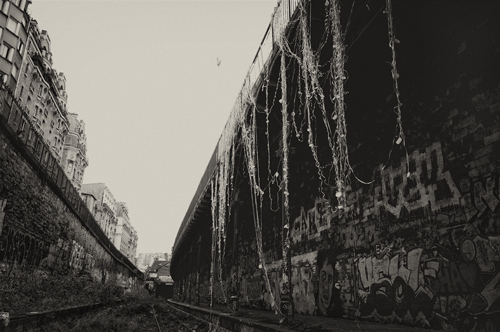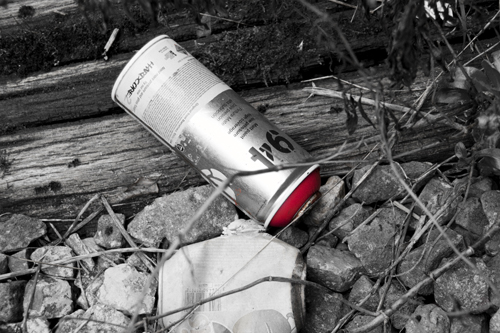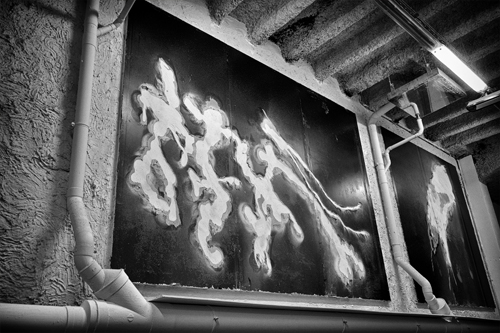
Something wicked sure did this way come. On the corner of la rue Belliard and la rue Leibniz, in the 18me arrondissement, the door at the top of the street wasn’t locked, so when the coast was clear I climbed 35 iron steps. The ladder was encased in a tubular rib cage, meant to break one’s fall if one slipped, but it only served to snag my camera backpack and chafe my jacket on the way down. I found myself on the abandoned rail line known as the Petite Ceinture, or the little belt. Schemed by the military in the mid-nineteenth century as a way to move troops and materials along the newly fortified city wall, le Chemin de fer de Petite Ceinture was financed privately and finished in 1852. Partially abandoned since 1934, it’s now a forbidden zone—though that doesn’t stop everyone from checking it out, and green thumbs and off-the-gridders especially like it: the sinuous site is replete with organic gardens, petits potagers. So do taggers, who use it for target practice, testing out forms and figures they plan to bomb the world above with. Beer cans, sneakers, condoms, bras, I even saw a Lexmark printer, retro “thro’ the furze.” This, I thought, is where digital comes to die. Spray paint cans by the hundreds, of course, a judicious collection of orange pylons, and nylon thigh-high lingerie leggings. Overgrown with weeds—and, I worried, poison ivy—the sluice looked like the aftermath of Bourbon Street, if New Orleans consigned its decadence to the dungeon, a cave, an open grave. Even the bird in my photo is plunging, a crumpled diacritical mark, a tailspin of dead, dread weight. The railings were strewn with ticker tape, as if a giant spider from Tolkien had clattered through, and there were white anti-asbestos masks caught in the frizzy webbing. A gauntlet haunted by heathens and hedons, the tunnel was draped with tinsel made from crushed and twisted plastic water bottles: a crude and eco-unfriendly, cartilaginous bling. Down here on the disused inner rail, graff is the riffraff’s elective feng shui. Not a party palace to paint the town red, but an infrared-light district. I thought of Christina Rossetti’s “Goblin Market,” her 1862 poem about two sisters, Lizzie and Laura, one of whom succumbs to the louche temptation, “Come buy, come buy.” In the “mossy glen” of the goblin bazaar, Laura trades her tresses for a morsel of their orchard merchandise:
She clipp’d a precious golden lock,
She dropp’d a tear more rare than pearl,
Then suck’d their fruit globes fair or red:

A collaboration by Horfée and Ken Sortais for “Lasco Project #3” at the Palais de Tokyo, “Biolensu” addresses “a post-apocalyptic universe dominated by barbarism,” according to Sortais, “a world governed by violence and clan wars, where the semblance of life is cadenced by murders and rapes.” Refusing to transpose their street graffiti tactics onto venerable institutional walls, the two French artists opted instead for a seemingly rough and ready “smear de rue,” akin to the panicked, unpolished shortcuts often necessitated by furtive, hasty, scandalous vandalism. They created their deformed shadows in conversation with Violence Jack, a manga written and illustrated by Gô Nagai in the early 70s. Three of the Japanese sagas were adapted for original video, and “Harem Bomber,” from 1986, was playing on the wall adjacent to the tableaux when I visited the exhibition last July. Using spray paint and acrylic to throw up a mural measuring 8’10” x 34’5”, Sortais and Horfée—both born in 1983 and graduates of L’École des Beaux-Arts in Paris—worked in full-color figural abstraction from screen captures of another Violence Jack episode, “Hell’s Wind,” which like the Lasco Project expo itself is set underground. On the facing wall, they sought to transcribe the stories’ weaponry—knives and shotguns, hatchets and hammers, chainsaws, hand grenades—, as well as its muscled virility, through formal means, by working fairly aggressively in plasterboard, mortar, and dust. After painting the surfaces a thick black, they applied a sander, to chew back down to the luminous stucco below, effectively flaying the pristine wall and leaving a cicatrix, mangy and rank: the emblem of our era. The halo of powder and debris spat out by the spinning blade of the sanding machine eventually settled around and below the grungy quasi-images, on the building’s pipes and wiring, as evidence of carnage and a wink to aerosol.

Andrew Zawacki is the author of five books of poetry: Unsun : f/11 (2019), Videotape (2013), Petals ...
Read Full Biography

